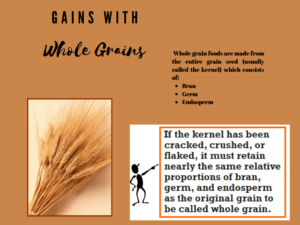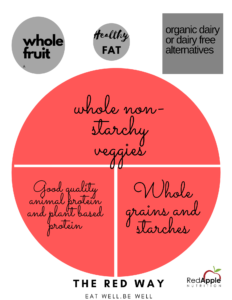Fifty years ago our food came from a farm, a garden or the butcher down the road. Today, we walk into a grocery store and are surrounded by hundreds of thousands of food items filled with preservatives and chemicals that we can barely pronounce. It’s true…we have over complicated the food system.
It is time that we simply get back to the basics and eat REAL food that comes from the Earth, not a laboratory. Food activist, Michael Pollan, says it best, “If it came from a plant eat it; if it was made in a plant, don’t!”
Our body recognizes food, real food, and knows what to do with food. When we choose foods that are laden with ingredients that no ordinary human should be consuming, our body fights back. It fights back in the form of inflammation, heart disease, gut dysfunction, sleep disorders, arthritis, chronic pain, need I go on? If only we can stop making it so complicated by jumping from one fad diet to the next, perhaps we could find the true meaning of what it means to get Back to the Basics. Eating clean and Balance is key!
Eat Clean
The term clean eating means eating whole foods that are minimally processed and as close to their natural form as possible. These foods include whole fruits, vegetables, grains and healthy fats as well as minimally processed snacks and packaged items.
Clean eating means focusing on foods that nourish your body and provide the most nutrients since these foods come in their most natural state. The more processed, the more its natural state has been altered and more chemicals, preservatives, sugar and processed fats have typically been added.
A good rule of thumb is, the closer a food is to its natural state, the better it is for you. Understanding what is in your food and where your food came from can help you eat cleaner. Read labels and choose foods that have less ingredients and have ingredients you can pronounce! Choose more fresh foods like fruits and vegetables! If you pick up an apple, there is no package…what you see is what you get.
When we adopt this form of eating, we have more energy, feel better and may even lose weight without ‘dieting’. This is a lifestyle that can be simple, effective and well balanced to help you reach your wellness goals.
Focus on Balance
We have all been told to eat a balanced diet. Ok, sounds easy, but what exactly does this mean? Eating balanced means you are eating a meal that simply provides the three main categories of Macronutrients: carbohydrates, fats, and proteins. These are our main sources of energy (or calories) needed to maintain body functions. It is important to eat a variety of macronutrients to obtain your needs of micronutrients: vitamins and minerals.
Macronutrients are comparable to the gas we put into our cars, while micronutrients are the oil we need to keep the car running optimally. If there is a deficit in either, we will not function at our optimal level. Our micronutrients work hard to help breakdown our macronutrients so that they can be metabolized properly to produce energy. When we balance our meals and get a variety of nutrients, we support our health in many ways.
Breaking Down the Macros
Protein: Without protein, life would not exist. Protein is found in many tissues of the body such as muscle, skin, and bone and is used for growth, maintenance and repair. It is important to eat enough protein to maintain healthy functioning. Amino acids, the building blocks of Protein are essential to life and are responsible for neurotransmitter activity. Neurotransmitters are chemical messengers that essentially steer every emotion as well as support our mood, sleep, hormone production and memory. Sources include:
- Animal–Meat, Fish, Poultry, Dairy
- Plant-Nuts, Beans, Seeds, non-GMO Soy, Nut butters (choose natural nut butters with very little added (salt and nuts only))
Fat: Sixty percent of the brain is fat, which makes it important to include fat on a daily basis. We also needs fats to absorb fat soluble vitamins like A, E, D and K. In addition, fat adds satiety to our meals and helps to shut off our hunger hormones. Ounce for ounce, fat does contain more calories than any other nutrient. However, quality of fat is most important rather than quantity. We recommend including a wide variety of fats including both plant-based and animal based foods (if desired). Avoid trans fat and be mindful of the quality of animal fat…we are what they eat! Choose grass-fed, organic meats when possible. Sources include:
- Saturated Fat-Grass-fed Beef, wild game, whole organic dairy products, grass-fed butter, bacon fat (choose no added nitrites and nitrates), coconut oil
- Unsaturated Fat-nuts, seeds, natural nut butters, avocados, fatty fish (salmon, tuna, herring, mackerel), extra virgin olive oil
- Trans Fat-stick margarine, commercially baked goods and snack foods made with hydrogenated oil (AVOID these fats most often)
Carbohydrates: Carbohydrates are a source of energy and are essential for cellular health. The key to carbohydrates is to choose whole grains, whole starches and whole fruits. These will provide more fiber. Fiber helps support digestion, reduces LDL cholesterol, improves blood sugars and keeps us full! Choose whole unrefined grains/whole starches for fiber and overall health! Avoid added refined sugar and sweets regularly including honey, maple syrup and other ‘natural’ sugars. Sugar is Sugar! Sources include:
- Grains–Bread, cereal, pasta, rice, quinoa, barley, bulgur, millet, buckwheat
- Beans and legumes
- Starchy vegetables like potatoes, corn, peas, lima beans, winter squash, beets
- Fruit
- Vegetables (very low carbohydrate)
- Sugar, sweets including honey and maple sugar
Refined vs. Unrefined Grains

Refined: processed, white grains, more ingredients added. (avoid enriched grains)
Unrefined: Whole, unprocessed, as nature intended, higher in fiber, protein and vitamins/minerals (choose whole grains)
Once you have an understanding of all the macronutrients, then you can build a plate. An easy and effective way to balance your macronutrients is to use The RED WAY Plate Planner. Below is an illustration of how we can practice balance with each meal. Use this to ensure you are getting a variety on your plate.

Final Thoughts
Eat Clean. Choose whole foods. Balance your plate. Keep it Simple and Get Back to the Basics!
For a more in depth understanding of whole food nutrition, clean eating and balance, consider signing up for our on demand virtual 8 week Back to Basics Program designed to help with accountability and easy to understand education about nutrition, balance, mindfulness and goal setting!



